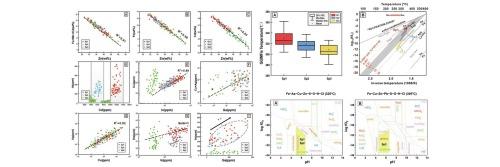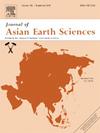云凯地区高城矽卡岩铅锌银矿床闪锌矿中in - cd - ga富集
IF 2.4
3区 地球科学
Q2 GEOSCIENCES, MULTIDISCIPLINARY
引用次数: 0
摘要
铟(In)、镓(Ga)和镉(Cd)是具有战略意义的关键金属,在高科技产业中有着广泛的应用。由于需求的增长和全球供应的限制,铟、镓、镉富矿床的成因和勘探受到了广泛的关注。中国南方云开域(华夏地块)含有大量的锌、铅多金属矿床,但对这些矿床中铟、镓、镉的潜力研究不足。为了填补这一空白,我们选择了具有代表性的矽卡岩型锌铅银矿床——高城矿,研究了铟、镓、镉在闪锌矿中的含量、空间分布和嵌合行为。野外调查和显微观察表明,高城具有透辉石、绿帘石、石榴石等多种矽卡岩矿物。已鉴定出三代闪锌矿,具有不同的矿物组合和颜色。电子探针微量分析(EPMA)和激光烧蚀电感耦合等离子体质谱(LA-ICP-MS)分析表明,每种闪锌矿具有不同的成分,特别是in, Ga和Cd浓度。在Sp1 (n = 56)中,In(均值= 414 ppm)、Ga(均值= 177 ppm)和Cd(均值= 11517 ppm)富集程度最高。其后两代闪锌矿的浓度呈下降趋势,其中Sp2 (n = 52)具有in(平均值271 ppm)、Ga(平均值119 ppm)和Cd(平均值6196 ppm), Sp3 (n = 49)具有in(平均值48 ppm)、Ga(平均值73 ppm)和Cd(平均值5732 ppm)。二元图表明,In在闪锌矿晶格中的替代机制是:Cu+(或Ag+) + In3+↔2Zn2+, Ga遵循类似的机制:Cu+(或Ag+) + Ga3+↔2Zn2+,而Cd的替代机制是:Cd2+↔Zn2+。在高城闪锌矿中观察到铟窗的影响,即高富集的铟与特定Cd浓度(4000 ~ 8000ppm, 10000 ~ 14000ppm)相关。然后,我们使用GGIMFis地温计计算了3代闪锌矿的结晶温度,从Sp1的331°C(平均)到Sp2的320°C,再到Sp3的309°C,呈现出明显的下降趋势。基于温度和热力学计算,硫逸度(fS2)呈逐渐减小的趋势,Sp1(−8 ~−5),Sp2(−10 ~−6),Sp3(−13 ~−9)。Sp1和Sp2前期的氧逸度(fO2)在−34 ~−28.5之间,pH值在4.9 ~ 6.7之间;Sp3后期的氧逸度(fO2)在−36 ~−31.5之间,pH值在4.6 ~ 6.6之间。综上所述,高温、高硫逸度、高氧逸度和弱酸性物理化学条件有利于In、Ga和Cd在闪锌矿中的掺入,其中温度和硫逸度起主导作用。这一新发现有助于建立未来矽卡岩型铅锌矿床的关键找矿指标,增强对in、Ga、Cd元素富集的认识。本文章由计算机程序翻译,如有差异,请以英文原文为准。

In-Cd-Ga enrichment in sphalerite from the Gaocheng skarn Pb-Zn-Ag deposit, Yunkai Domain, South China
Indium (In), Gallium (Ga), and Cadmium (Cd) are strategic critical metals with widespread applications in high-tech industries. The growing demand and global supply limitations have led to widespread attention on the genesis and exploration of deposits rich in In, Ga, and Cd. The Yunkai Domain (Cathaysia Block, South China) contains numerous Zn-Pb polymetallic deposits, but the potential of In, Ga, and Cd in these deposits has been insufficiently studied. To fill this gap, we selected the Gaocheng deposit, a representative skarn-type Zn-Pb-Ag deposit, to investigate the content, spatial distribution, and incorporation behavior of In, Ga, and Cd in sphalerite, which serves as their major mineral host. Field surveys and microscopic observations revealed that the Gaocheng is featured with a variety of skarn minerals such as diopside, epidote, and garnet. Three generations of sphalerite have been identified with distinct mineral assemblages and colors. Electron probe microanalysis (EPMA) and laser ablation inductively coupled plasma mass spectrometry (LA-ICP-MS) analyses revealed that each sphalerite has distinct compositions, in particular In, Ga, and Cd concentrations. In Sp1 (n = 56), In (mean = 414 ppm), Ga (mean = 177 ppm), and Cd (mean = 11517 ppm) are the most enriched. The concentrations in the subsequent two generations of sphalerite show a decreasing trend, with Sp2 (n = 52) having In (mean = 271 ppm), Ga (mean = 119 ppm), and Cd (mean = 6196 ppm), and Sp3 (n = 49) having In (mean = 48 ppm), Ga (mean = 73 ppm), and Cd (mean = 5732 ppm).
Binary diagrams indicate that the substitution mechanism of In into the sphalerite lattice is: Cu+ (or Ag+) + In3+ ↔ 2Zn2+, and Ga follows a similar mechanism: Cu+ (or Ag+) + Ga3+ ↔ 2Zn2+, while the substitution mechanism for Cd is: Cd2+ ↔ Zn2+. It is noticeable that the effect of the indium window, the highly enriched In, correlating with the specific Cd concentrations (4000–8000 ppm, 10000–14000 ppm), is observed in the Gaocheng sphalerite. Then, we use the GGIMFis geothermometer to calculate the crystallization temperatures of three sphalerite generations that exhibit a clear decreasing trend from 331 °C (mean) for Sp1 through 320°C for Sp2, to 309 °C for Sp3. Based on temperature and thermodynamic calculations, the sulfur fugacity (fS2) shows a gradual decreasing trend, with Sp1 (−8 to −5), Sp2 (−10 to −6), and Sp3 (−13 to −9). Meanwhile, the oxygen fugacity (fO2) of Sp1 and Sp2 in the earlier stages ranges from −34 to −28.5, with pH values between 4.9 and 6.7, while in the later stages, the oxygen fugacity (fO2) of Sp3 ranges from −36 to −31.5, with pH values between 4.6 and 6.6. Collectively, we conclude that high temperature, elevated sulfur fugacity, higher oxygen fugacity, and weakly acidic physicochemical conditions are favorable for the incorporation of In, Ga, and Cd into sphalerite, with temperature and sulfur fugacity playing a more dominant role. This novel finding helps establish key exploration indicators for skarn Zn-Pb deposits in the future, enhancing our understanding of the enrichment of In, Ga, and Cd elements.
求助全文
通过发布文献求助,成功后即可免费获取论文全文。
去求助
来源期刊

Journal of Asian Earth Sciences
地学-地球科学综合
CiteScore
5.90
自引率
10.00%
发文量
324
审稿时长
71 days
期刊介绍:
Journal of Asian Earth Sciences has an open access mirror journal Journal of Asian Earth Sciences: X, sharing the same aims and scope, editorial team, submission system and rigorous peer review.
The Journal of Asian Earth Sciences is an international interdisciplinary journal devoted to all aspects of research related to the solid Earth Sciences of Asia. The Journal publishes high quality, peer-reviewed scientific papers on the regional geology, tectonics, geochemistry and geophysics of Asia. It will be devoted primarily to research papers but short communications relating to new developments of broad interest, reviews and book reviews will also be included. Papers must have international appeal and should present work of more than local significance.
The scope includes deep processes of the Asian continent and its adjacent oceans; seismology and earthquakes; orogeny, magmatism, metamorphism and volcanism; growth, deformation and destruction of the Asian crust; crust-mantle interaction; evolution of life (early life, biostratigraphy, biogeography and mass-extinction); fluids, fluxes and reservoirs of mineral and energy resources; surface processes (weathering, erosion, transport and deposition of sediments) and resulting geomorphology; and the response of the Earth to global climate change as viewed within the Asian continent and surrounding oceans.
 求助内容:
求助内容: 应助结果提醒方式:
应助结果提醒方式:


